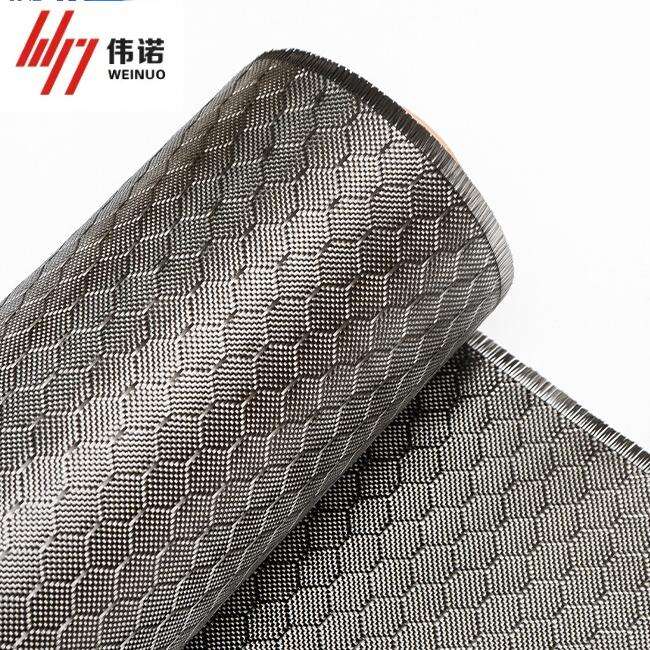ההשפעה המהפכנית של חומרים מרוכבים מתקדמים בייצור
במישור המתפתח תמיד של הייצור המודרני, בְּכֶסֶת פִּתְאוֹמִי פַּחַד צבר מוניטין כחומר מהפכני שהופך את התעשייה, מן האווירודינמיקה ועד לענף הרכב. חומר הרכיבים המדהים הזה משלב עמידות יוצאת דופן עם משקל נמוך במיוחד, מה שעושה אותו לבחירה המובילה של יצרנים המחפשים ביצועים וחיים אורך. ככל שהתעשיות דוחקות את הגבולות של האפשרי בפיתוח מוצרים, תוסס הפיברגלאס ממשיך להוכיח למה הוא בחזית חדשנות החומרים.
העדפה גוברת של בוקסית סיבי פחמן עשויה התעשייה נובעת מהשילוב שלה בתכונות שאין תחרות להן בחומרים מסורתיים. בין אם מדובר בבניית כלי רכב בעלי ביצועים גבוהים, רכיבי תשתיות עמידים או יישומים מתקדמים בתחום האווירונאוטיקה, חומר רב-תכליתי זה מביא תוצאות יוצאות דופן שמוצדקות את מקומו המוביל בשוק.
הכרת תכונות בוקסית סיבי פחמן
יחס עוצמה-למשקל מופלג
אחת התכונות המרשימות ביותר של בד סיבי פחמן היא היחס יוצא הדופן בין עוצמה למשקל. לפי משקל, הוא מتفوق על פלדה ואלומיניום, תוך שהוא שוקל פחות בהרבה. מאפיין ייחודי זה מאפשר לייצר מוצרים שהן לא רק חזקות יותר אלא גם קלות בהרבה בהשוואה לאלו המסורתיות. המשקל הנמוך יותר תורם לשיפור יעילות הדלק ברכבים, שיפור הניידות ביישומים תעופתיים, וטיפול קל יותר בפרויקטים בנייה.
המבנה המולקולרי הייחודי של בד סיבי פחמן מאפשר לו לעמוד בלחצים עצומים תוך שמירה על שלמותו המבנית. העוצמה המובנית הזו נובעת מסיבי הפחמן השזורים בצורה צפופה שיוצרים את הבד, ויוצרים חומר המסוגל לעמוד בעומסים קיצוניים מבלי להתעוות או להיכשל.
עמידות יוצאת דופן ושנות חיים ארוכות
כאשר יצרנים משקיעים בבד סיבי פחמן, הם בוחרים בחומר העומד במבחן הזמן. בניגוד לחומרים מסורתיים שעלולים להיגרם או להתדרדר עם הזמן, בד סיבי פחמן שומר על תכונותיו לאורך מחזור החיים שלו. עמידות יוצאת דופן זו תורמת לצריכת תחזוקה מופחתת ותקופת שירות ארוכה יותר של המוצרים המיוצרים.
עמידות החומר בפני גורמים סביבתיים, כולל קרינת UV, חשיפה לכימיקלים ושינויי טמפרטורה, הופכת אותו לבעל ערך מיוחד ביישומים קיצוניים. עמידות זו מבטיחה שمنتجات המיוצרות באמצעות בד סיבי פחמן ישארו אמינות ותפקודיות לאורך תקופה ממושכת, ויספקו תשואה גבוהה על ההשקעה.
יישומי ייצור ורחב-תפוקתיות
חדשנות באווירspace ובעופה
תעשיית התעופה והחלל הייתה כוח חלוץ באימוץ בד סיבי פחמן. יצרני מטוסים משתמשים בחומר מתקדם זה בהרחבה בבניית מטוסים מודרניים, החל מרכיבי גוף המטוס ועד מבני כנפיים. חוזקו הגבוה ומאפייני המשקל הנמוך של החומר תורמים ישירות לשיפור יעילות הדלק ולהגדלת קיבולת המטען.
כלי טיס מסחריים מודרניים כוללים כמויות גדולות של בד פיברגלאס בבנייתם, ובהן עד 50% ממשקל המבנה הכולל. אימוץ נרחב זה מדגים את הרישום המוכח של החומר באחת התעשיות הדemandיניות ביותר ובדרישות הבטיחות הגבוהות ביותר.
שיפור ביצועים בתחום הרכב
בתחום האוטומotive, בד הפיברגלאס מהפכן את עיצוב והביצועים של כלי רכב. מכוניות ספורט יקרות ורכב פרטי מציגות ביתר תדירות רכיבים מפחמן, מפנלי גוף ועד אלמנטים מבניים. היכולת של החומר לספוג אנרגיית מכה תוך שמירה על שלמות מבנית הופכת אותו לערכיים במיוחד ביישומים קריטיים לבטיחות.
יצרנים מעריכים את העובדה שסיבי פחמן מאפשרים להם להפחית את משקל הרכב מבלי להקריב ביטחון או שלמות מבנית. הפחתת המשקל תורמת לשיפור בתפעול, האצה וכفاءה בצריכת דלק, מה שהופך אותה לאפשרות מושכת הן מבחינת ביצועים והן מבחינת שיקולים סביבתיים.
ניתוח עלות-תועלת וערך ארוך טווח
שקול השקעה ראשונית
בעוד עלות הכניסה של בד סיבי פחמן עשויה להיות גבוהה יותר לעומת חומרים מסורתיים, יצרנים מגלים בהדרגה את היתרונות הכלכליים לטווח הארוך. עמידות החומר וצרכיו הנמוכים מאוד בטיפול ובתחזוקה מובילים לעתים קרובות להפחתת עלות הבעלות הכוללת לאורך מחזור החיים של המוצר. בנוסף, התקדמות בתהליכי ייצור ממשיכה לעשות את בד סיבי הפחמן זול יותר ביישום.
ההשקעה הראשונית מ+offsetted לעתים קרובות על ידי הפחתת עלויות תפעול, הארכת מחזור חיים של המוצר ושיפור מאפייני הביצועים. יצרנים יכולים גם לדייק את השימוש בחומר באמצעות טכניקות עיצוב מתקדמות, מה שמשפר עוד יותר את יעילות העלויות ביישומים של בד סיבי פחמן.
יתרונות בביצועים ובקיימות
השלכות הסביבה של שימוש בבד סיבי פחמן עקביות עם מטרות העמידות המודרניות. התכונות הקלות של החומר תורמות להפחתת צריכה של אנרגיה ביישומי תחבורה, בעוד עמידותו משמעה פחות החלפות ופחות פסולת לאורך זמן. גורמים אלו הופכים אותו לאפשרות מושכת ליצרנים המחויבים לאחראית סביבתית.
יתרה מכך, עמידות החומר בתהליך שחוק והרס מצמצמת את הצורך בחיפויים וטיפולים מגנים, ובכך מקטינה את ההשפעה הסביבתית של תהליכי תחזוקה. ככל שעמידות הופכת להיות חשובה יותר בהחלטות ייצור, היתרונות הללו הופכים למשמעותיים יותר.
מגמות וחדשנות העתיד
טכניקות ייצור מתקדמות
עתידם של בדים מסיבי פחמן בייצור נראה מבטיח, שכן שיטות ויישומים חדשים ממשיכים לצוץ. תהליכי ייצור אוטומטיים וטכניקות משופרות של יישור סיבים הופכים את הייצור ליעיל ועקבי יותר. התקדמויות אלו מסייעות להפחית עלויות תוך שמירה על תכונותיו המעולות של החומר.
חדשנות בטכנולוגיות מחזור גם כן הופכת את בד סיבי הפחמן לבר-קיימא יותר, ובכך מטפלת באחת הבעיות הראשיות בנוגע לחומרים מרוכבים. ככל שטכנולוגיות אלו בשלות, החומר הופך לאפשרות מושכת אף יותר לייצרנים בעלי דאגה לסביבה.
הרחבה של יישומים
תעשיות חדשות ממשיכות למצוא יישומים לבד סיבי פחמן, מתקני אנרגיה מתחדשת עד להתקנים רפואיים. הגיוון והתכונות הביצועיות של החומר הופכים אותו מתאים לתחום יישומים בהמשכה גדלה בייצור. הרחבת היישומים מעודדת חדשנות נוספת ואופטימיזציה של עלויות בתהליכי ייצור.
השילוב של טכנולוגיות חכמות עם בד סיבי פחמן פותח אפשרויות חדשות למעקב ולתחזוקה של שלמות מבנית בזמן אמת. התפתחויות אלו חשובות במיוחד ביישומים קריטיים שבהם ביצועים ובטיחות הם בעלי חשיבות עליונה.
שאלות נפוצות
איך בד סיבי פחמן משתווה לחומרים מסורתיים במונחים של אורך חיים?
בד פיברגלאס עמיד יותר מחומרים מסורתיים כמו פלדה ואלומיניום, במיוחד ביישומים שבהם התנגדות לusz fatigue והתנגדות לאוכלוס קריטיים. החומר יכול לשמור על תכונות המבנה שלו לאורך עשורים עם דעיכה מינימלית, ועתים קרובות עולה על אורך החיים הפורקי של חומרים קונבנציונליים באופן משמעותי.
מה גורם לבד סיבי פחמן להיות מתאים במיוחד ליישומים באווירspace?
שילוב של יחס עוצמה-למשקל יוצא דופן, עמידות לusz fatigue ויציבות תרמית הופך את בד הפיברגלאס לאידיאלי ליישומים באווירודינמיקה. תכונות אלו מאפשרות בניית כלי טיס קלים יותר ושימוש בדלק יעיל יותר, תוך שמירה על הסטנדרטים הגבוהים ביותר של בטיחות ושלמות מבנית הנדרשת בתעופה.
האם קיימות מגבלות לשימוש בבד פיברגלאס בייצור?
בעוד שבד פיברגלאס מציע יתרונות רבים, יצרנים חייבים לקחת בחשבון גורמים כגון עלות ראשונית, דרישות לעיבוד מיוחד, וצורך בידע עיצובי ספציפי. עם זאת, מגבלות אלו נדחות לעתים קרובות על ידי תכונות הביצועים הגבוהות של החומר והיתרונות ארוכי הטווח שלו ביישומים המתאימים.


